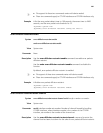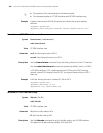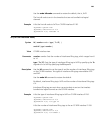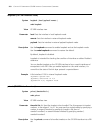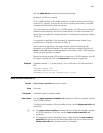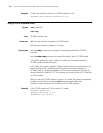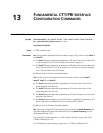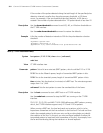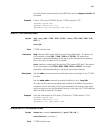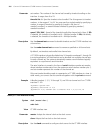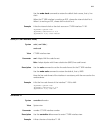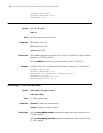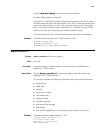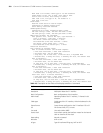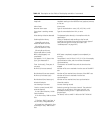
214 CHAPTER 13: FUNDAMENTAL CT1/PRI INTERFACE CONFIGURATION COMMANDS
If the number of the pulses detected during the total length of the specified pulse
detection intervals is smaller than the pulse-recovery threshold, a LOS alarm
occurs. For example, if the two thresholds take their defaults, a LOS alarm is
created if the number of pulses detected within 176 pulse intervals is less than 22.
Description Use the
alarm-threshold command to set LOS, AIS, or LFA alarm thresholds on
the CT1/PRI interface.
Use the
undo alarm-threshold command to restore the defaults.
Example # Set the number of detection intervals to 300 for the pulse detection duration
threshold.
<Sysname> system-view
[Sysname] controller t1 2/0
[Sysname-T1 2/0] alarm-threshold los pulse-detection 300
bert (CT1/PRI interface view)
Syntax bert pattern { 2^15 | 2^20 } time minutes [ unframed ]
undo bert
View CT1/PRI interface view
Parameter pattern: Sets a bit error rate test (BERT) pattern, which could be 2^15 or 2^20.
2^15: Two to the fifteenth power, length of transmitted BERT pattern in bits.
2^20: Two to the twentieth power, length of transmitted BERT pattern in bits.
time minutes: Sets the duration (in minutes) of a BERT test. The minutes argument
ranges from 1 to 1,440.
unframed: Sets the test pattern to cover the overhead bits of the frame.
Description Use the
bert command to start a BERT test on a CT1/PRI interface.
Use the
undo bert command to stop the BERT test running on the CT1/PRI
interface.
ITU O.151, ITU O.153, and ANSI T1.403-1999 define many BERT patterns, among
which, the CT1/PRI interface supports only 2^15 and 2^20 at present.
When running a BERT test, the local end sends out a pattern, which is to be
looped over somewhere on the line and back to the local end. The local end then
checks the received pattern for bit error rate, and by so doing helps you identify
the condition of the line. To this end, you must configure loopback to allow the
transmitted pattern to loop back from somewhere on the line, for example, from
the far-end interface by placing the interface in a far-end loopback.




